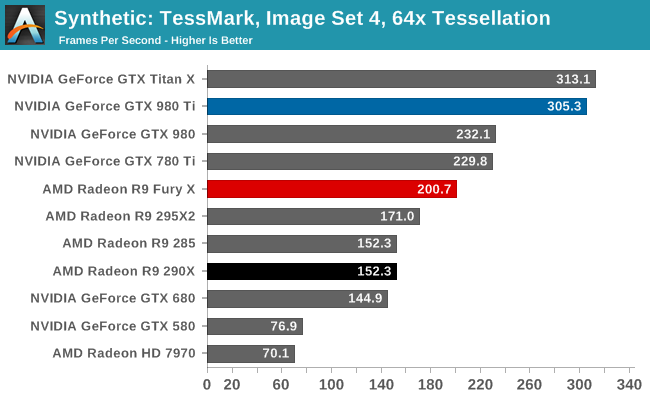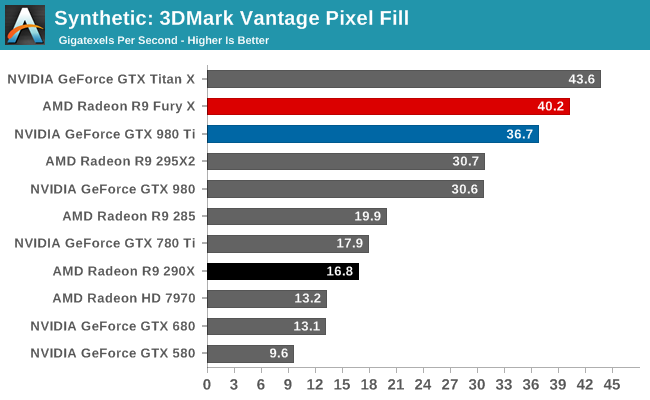The AMD Radeon R9 Fury X Review: Aiming For the Top
by Ryan Smith on July 2, 2015 11:15 AM ESTSynthetics
As always we’ll also take a quick look at synthetic performance. Since Fiji is based on the same GCN 1.2 architecture as Tonga (R9 285), we are not expecting too much new here.

First off we have tessellation performance. As we discussed in greater detail in our look at Fiji’s architecture, AMD has made some tessellation/geometry optimizations in GCN 1.2, and then went above and beyond that for Fiji. As a result tessellation performance on the R9 Fury X is even between than the R9 285 and the R9 290X, improving by about 33% in the case of TessMark. This is the best performing AMD product to date, besting even the R9 295X2. However AMD still won’t quite catch up to NVIDIA for the time being.

As for texture fillrates, the performance here is outstanding, though not unexpected. R9 Fury X has 256 texture units, the most of any single GPU card, and this increased texture fillrate is exactly in line with the theoretical predictions based on the increased number of texture units.

Finally, the 3DMark Vantage pixel fillrate test is not surprising, but it is none the less a solid and important outcome for AMD. Thanks to their delta frame buffer compression technology, they see the same kind of massive pixel fillrate improvements here as we saw on the R9 285 last year, and NVIDIA’s Maxwell 2 series. At this point R9 Fury X’s ROPs are pushing more than 40 billion pixels per second, a better than 2x improvement over the R9 290X despite the identical ROP count, and an important reminder of the potential impact of the combination of compression and HBM’s very high memory bandwidth. AMD’s ROPs are reaching efficiency levels simply not attainable before.










458 Comments
View All Comments
silverblue - Friday, July 3, 2015 - link
To the point of lunacy. It'd need to be a title that currently plays like a dog's dinner, everything else would be a few percent here and there.loguerto - Friday, July 3, 2015 - link
Thank you Ryan, thank you so much on at least mentioning Vulkan aside of dx12.royalcrown - Friday, July 3, 2015 - link
"Almost 7 years ago to this day, ANANDTECH formally announced their “FURY X review stratagy.":D J/K Ryan, no big deal, people get sick !
royalcrown - Friday, July 3, 2015 - link
Wide and slow makes it fast ?So basically HBM is the 40 or 80 pin ribbon cable of today right Ryan ? Do you see serial busses being abandoned for parallel again someday in your opinion ?
Refuge - Friday, July 3, 2015 - link
It almost feels like we go in cycles with that... doesn't it?Ryan Smith - Friday, July 3, 2015 - link
We're definitely swinging back towards highly parallel buses at the moment.http://www.anandtech.com/show/9266/amd-hbm-deep-di...
althaz - Friday, July 3, 2015 - link
Horses for courses. HBM is perfectly suited to graphics memory - wide is really the only thing you need, event he "slow" speed of HBM is beyond what's needed. Making the memory faster makes virtually no performance difference. The only reason it even operates as fast as it does is to get the bandwidth up (bandwidth is the product of speed and width).Think of a hose - with the same total pressure, a thinner hose will have a higher "speed" (as the water coming out will have a faster velocity) than a wider hose, but when all you need to do is fill the bucket, a wider hose is obviously better - which is the case here.
mdriftmeyer - Sunday, July 5, 2015 - link
You're attempt at Nozzle pressure in a Fluid Dynamics analogy is solid, but if he cannot fathom that a wider bandwith bus allows for less round trips than he's an idiot.zodiacfml - Saturday, July 4, 2015 - link
They have gone highly parallel because HBM is primarily created for mobile devices in the future.Shagatron - Friday, July 3, 2015 - link
I had to stop reading after the author used the term "reticle limit" to describe a 28nm chip. I really wish the "enthusiast press" wouldn't use real terms they don't understand.